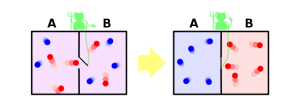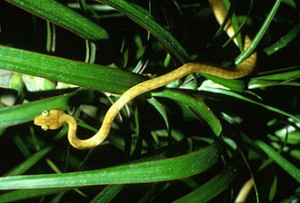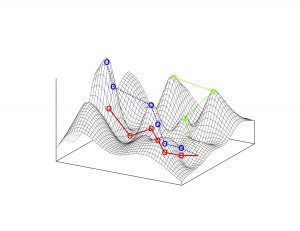In the history of science, thought experiments have often played an important role, either by helping to refute established theories, for example Galileo’s Leaning Tower of Pisa experiment, which refutes Aristotelian gravity, or by helping to conceive of new theories, for example Einstein’s special (chasing light beam) and general (elevator) theories of relativity. Sometimes the results of thought experiments appear counterintuitive, or even to violate the laws of nature, even though the assumptions all seem obviously correct. Of course this would have to be the work of a malevolent, supernatural being, so a demon is blamed.
Maxwell’s Demon
The most famous example is Maxwell’s demon. This demon appears to violate the second law of thermodynamics by operating a door in a small hole in the partition between two containers, and only letting fast molecules pass into one of the containers, resulting in an increase in temperature difference over time. However, a more careful analysis, which includes the demon’s metabolism as part of the system, shows that the second law isn’t really violated. So if you know your physics, there really is no need to invoke a demon.

Most thought experiment demons are found in physics or philosophy, but biology also has one, the Darwinian demon. There are actually, as far as I can tell, four different kinds of Darwinian demon.
Law’s Demon
The first one was mentioned by Richard Law in a 1979 paper [1] on the life history effects of age-specific predation. He observes that there are always constraints on reproduction, of which predation is just one. By contrast, an organism that can reproduce without incurring any costs, and which in general can maximize all aspects of fitness simultaneously, is a Darwinian demon. This is an organism that reproduces immediately after birth, utilizes all resources for reproduction and lives forever. It’s mentioned only once at the beginning of the paper, and is of no significance for the rest of it. However, as a meme, it’s struck a chord with many since then, and has taken on a life of its own and evolved.
Invasive Species

The most familiar product of Darwinian demon evolution is the invasive species. These are species that were introduced from outside their native distribution, and may eventually become so dominant that they become ecologically and sometimes even economically disruptive. Traits that many invasives have in common include fast growth, rapid reproduction, and high dispersal ability, traits that also characterize Law’s demon. Invasives aren’t quite as demonic as Law’s demon, but have the unfortunate trait of real-life existence — as opposed to just being the product of a thought experiment. They are what I call local Darwinian demons. For example, the brown tree snake (Boiga irregularis), which was introduced to Guam from Southeast Asia, has been devastating to the fauna of Guam, but it hasn’t spread beyond Guam yet. The term ‘local’ isn’t just meant in the geographical sense, but also in terms of ecological niche breadth. Even invasives have to coexist with each other to varying degrees. Very few invasives are as dominant as zebra mussels (Dreissena polymorpha) or kudzu (Pueraria spp., a.k.a. the vine that ate the South), and even they coexist with a few other species.
Mysterious Dominance
Since the main trait of invasives and any other Darwinian demon is dominance, why not call any species that exhibits any level of unusual or inexplicable dominance — no matter how fleeting or subtle — a Darwinian demon? This seems to be the most common use of the term today, and is wonderfully illustrated in Jonathan Silvertown’s book Demons in Eden [4]. One of the poster species for this sort of demon is duckweed (Lemna minor). Duckweed is native in most of the Northern hemisphere, and is known to often behave like an invasive within its native range. It can go from a few individuals that have survived the winter to completely covering entire bodies of water within a few months. An example can be seen in the featured photo, which was taken in the Mittellandkanal in Northern Germany. One reason it can reproduce so quickly is because it does so asexually, another is that it takes advantage of an abundance of nutrients from agricultural run-off, some of which are otherwise limiting factors for water plant growth, such as phosphorous.

But most examples of demons in Silvertown’s book exhibit far lower levels of dominance. He writes about biodiversity research on Barro Colorado Island in Panama, which has over 500 tree species on 15.6 km2, and any species that takes up more than its fair share of the island he calls a Darwinian demon! An even more extreme example of his liberal use of the designation as Darwinian demon is his claim that every species that ever existed must once have been a demon since it must have started from a small population. This, of course, can’t be true, since most species arise as a result of geographic separation, which does not require a change in population size. But I have a lot of sympathy for his enthusiasm for adaptive radiation and ecological speciation. (Why will become clear in an upcoming article.)
Leimar’s Demon

A very different kind of Darwinian demon emerged in 2001 with the publication of a paper by Olof Leimar [2]. This one resembles Maxwell’s demon in that it creates nonrandom fitness-enhancing mutations. Normally, mutations are random, and almost all of them are fitness-reducing. Of course, this kind of demon also doesn’t exist, but it’s a useful modeling tool for exploring the evolutionary potential of life. Due to the random nature of mutations, an organism may never make it from a local to a global fitness peak (green path in the image on the right), but this Darwinian demon knows where in the fitness landscape the global fitness peaks are located and creates exactly those mutations needed to get there (blue path).
Hutchinsonian Demon
The fourth one is the Hutchinsonian demon, named after Evelyn Hutchinson, a pioneer in the field of community ecology. This is the community ecology demon, introduced by Kneitel & Chase in a 2004 paper on trade-offs in community ecology [3]. Trade-offs are one of the main reasons why high levels of biodiversity are maintained in ecosystems. For example, consider defenses against predators. Turtles are heavily armored but slow, but if a predator is hungry and persistent enough, it can still occasionally manage to eat one. Lizards are quick, but if caught can easily be eaten. The trade-off is obvious, but a Hutchinsonian demon would not only be more heavily armored than a turtle, it would also be even quicker than a lizard. Of course, there are many more kinds of trade-off, such as cold versus hot climate or diurnal versus nocturnal adaptations. A Hutchinsonian demon dominates a community “because it is the best at colonizing new patches, utilizing all the resources, avoiding predators and resisting stresses” [3]. Generally speaking, Darwinian demons don’t have to worry about trade-offs. That’s what makes them so demonic.
As I’ve mentioned at the beginning, demons typically don’t really exist – they’re just thought experiments. Invasives and Silvertown’s demons are one exception, but what about Hutchinsonian demons? One might think that invasives would qualify as Hutchinsonian demons, except that species are very rarely intrinsically invasive — they acquire their invasiveness through human actions. They are species that humans have taken out of the coevolutionary network they evolved in — where they face the same kinds of trade-offs that other species in their native community do — and put them in a new environment where they face fewer trade-offs, which gives them an unfair advantage (such as a lack of predators and parasites) over species in their new community. Moreover, invasives still face some trade-offs, which limits their ability to spread to new habitats or geographical areas. You won’t find zebra mussels dominating any terrestrial habitat, and kudzu only ate the South, not the North.
And yet, I do believe that a real-life Hutchinsonian demon exists. Considering the ubiquity of trade-offs in real life, it may be hard to image that such a mythical beast could be real. Could there really be an animal that is better armored than a turtle and quicker than a lizard? (And that’s only one trade-off.) You don’t have to go very far to see this species — just get in your car! Not only could you get away from any predator chasing after you; if you did stop, you’d still be safe inside the car. And this applies to any habitat, even those we normally don’t live in, like the ocean. It doesn’t take much of a boat to get away from the most formidable oceanic predator, a pod of orcas. And even if they did catch up, you’d still be safe and could enjoy watching them. Indeed, I am talking about us humans as global Hutchinsonian demons.
While it’s commonly known that humans don’t have any predators, and are unsurpassed in resisting stresses, it may be less appreciated how important the other two defining characteristics of Hutchinsonian demons are for understanding our ecological nature. To some environmentalists our superior ability to colonize new patches is just a euphemism for “invasive cancer of the Earth”. If we want to settle somewhere we do it; we don’t let any other species get in the way. And if other species are already there, we just remove them, no matter what species. No other species has ever had this luxury. But I believe that our most demonic characteristic is our ability to utilize all resources. Every species occupies an ecological niche, which means that it specializes in using a specific set of resources. There is a wide spectrum from extreme specialists to generalists, but even generalists aren’t even close to being able to utilize all the potential resources in their environment. Bears, for example, don’t eat wood like termites do, or catch flying birds like peregrine falcons. Humans, on the other hand, can not only outcompete any species for any resource, we can use resources that no other organism can, such as fossil fuels, nuclear energy, water in deep aquifers, solar power where plants can’t grow, etc. As a matter of fact, we can take advantage of any resource that is theoretically exploitable; in some cases it may just be a matter of time until the proper technology is developed, in others it’s a question of whether exploitation is economical. This is why I like to answer the question of what our ecological niche is with “All of them!”.
Cultural Evolution as a Cultural Version of Leimar’s Demon
So how did we become global Hutchinsonian demons? Interestingly, another Darwinian demon may be involved. As I will explain in greater depth in a future article, the main reason we are so dominant is because we’ve invented a new form of evolution that is much faster than genetic evolution, and that is cultural evolution. Another advantage of cultural evolution — besides being faster — is that we can come up with radically new concepts without having to implement inferior intermediate versions. This is why we were able to invent the wheel; it could never evolve through genetic evolution. Our minds can simulate different versions of new concepts and discard those that appear to be inferior. So we can go straight from one adaptive peak (legs) to an even higher one (wheels) while avoiding the valley of maladaptedness. Sound familiar? Yes, this does look like a cultural version of Leimar’s demon.
What does the Emergence of a Global Darwinian Demon mean for the Biosphere?
 Finally, I would like to emphasize the significance of the real-life existence of any global Darwinian demon (from now on, when I refer to humans as Darwinian demons, I really mean global Hutchinsonian demons). Since it can utilize any resource and outcompete any organism for any resource, it follows that its dominance must also continue to increase. And if it can evolve much faster than other organisms, none of them will ever be able to catch up and begin to impede this increase in dominance. As a result, the dominance will eventually be complete, which of course is bad news for other species. In other words, the emergence of a global Darwinian demon will always lead to an evolutionary transition. As far as we know, this has never happened before in the history of life, but this is the situation we are in today.
Finally, I would like to emphasize the significance of the real-life existence of any global Darwinian demon (from now on, when I refer to humans as Darwinian demons, I really mean global Hutchinsonian demons). Since it can utilize any resource and outcompete any organism for any resource, it follows that its dominance must also continue to increase. And if it can evolve much faster than other organisms, none of them will ever be able to catch up and begin to impede this increase in dominance. As a result, the dominance will eventually be complete, which of course is bad news for other species. In other words, the emergence of a global Darwinian demon will always lead to an evolutionary transition. As far as we know, this has never happened before in the history of life, but this is the situation we are in today.
Objections
I know that some will disagree with this line of reasoning. The main objections to a significant increase in human dominance seem to be:
Education. If we just do a better job educating people about how detrimental our impact on nature is, we will change our behavior to lessen our impact.
Demographic transition. All we have to do is encourage birth control and empower women; that will automatically take care of the population problem.
Ecosystem services. All we have to do is put a dollar value on all ecosystem services. Seeing the great economic value of healthy ecosystems will be incentive enough to do whatever it takes to halt the degradation of ecosystems. If we don’t take action, the loss of ecosystem services will lead to the global collapse of civilization, which will end the era of human dominance.
Sustainability. Natural ecosystems and some traditional cultures apparently are sustainable, which proves that sustainability is possible, and we can learn from them. Elinor Ostrom received the Nobel prize in economics for showing that we can avoid the tragedy of the commons.
Biophilia. Since the love of nature is part of human nature, we will do more to reduce our ecological footprint once we see that the beauty of nature is vanishing.
Ethics. We have a moral obligation to preserve nature for future generations, and other species have as much a right to exist as we do.
If I’ve missed any, please let me know. In future articles I will shed some scientific light on each of these objections and show that they have more to do with wishful thinking than with reality.
Conclusion
That humans are ecologically dominant and an increasing threat to the existence of natural ecosystems is well known. However, it is usually treated as a political/sociological/economic/ethical issue. But the unprecedented ecological dominance of one species is ultimately an ecological phenomenon. So what I have done is to examine it in the scientific light of ecology, with the result that we are global Darwinian demons. I believe that this new view of human nature has the potential to make a significant contribution to the consilience of biology and the social sciences.
References
1. Law, R. (1979). Optimal Life Histories under age-specific Predation. American Naturalist 114: 399-417.
2. Leimar, O. (2001). Evolutionary Change and Darwinian Demons. Selection 2(1-2):65–72.
3. Kneitel, J.M. & Chase, J.M. (2004). Trade-offs in community ecology: linking spatial scales and species coexistence. Ecology Letters, 7, 69–80.
4. Silvertown, J. (2005). Demons in Eden. The paradox of plant diversity. Chicago and London: Chicago University Press.



this is a test.